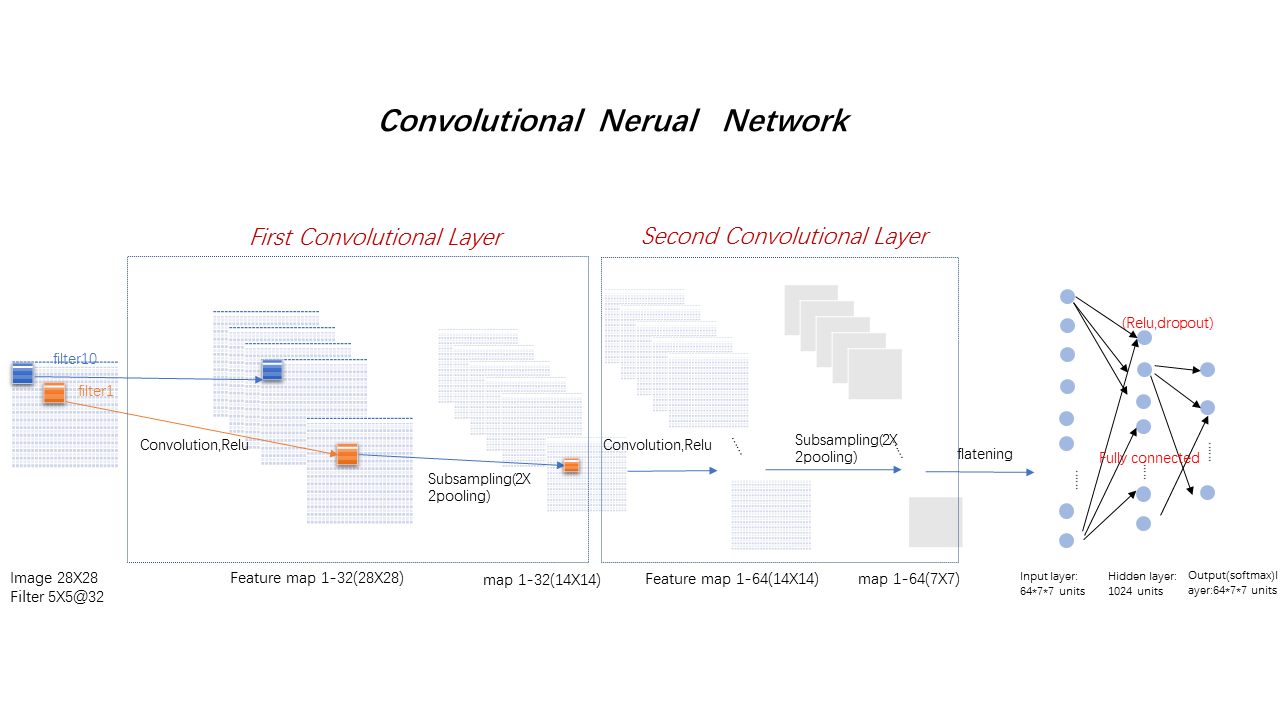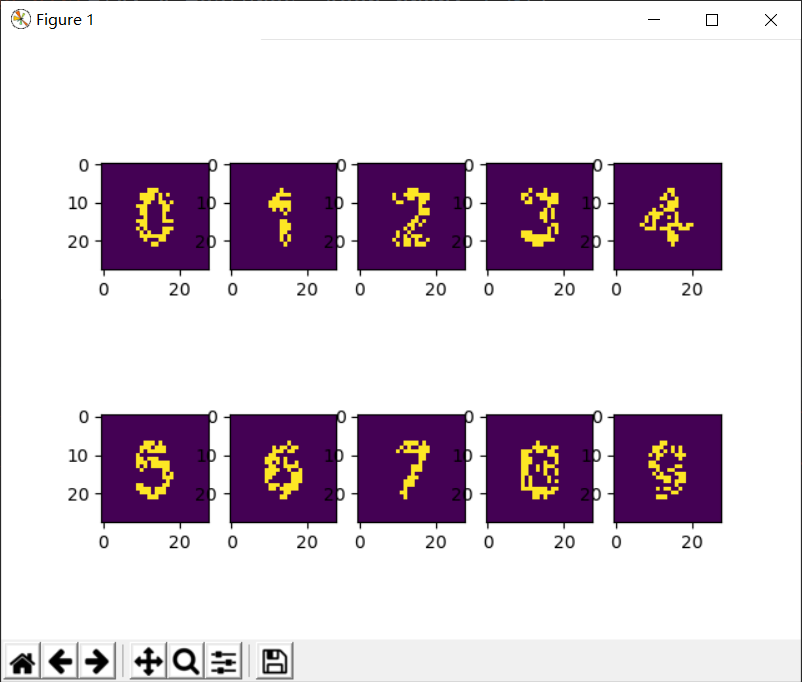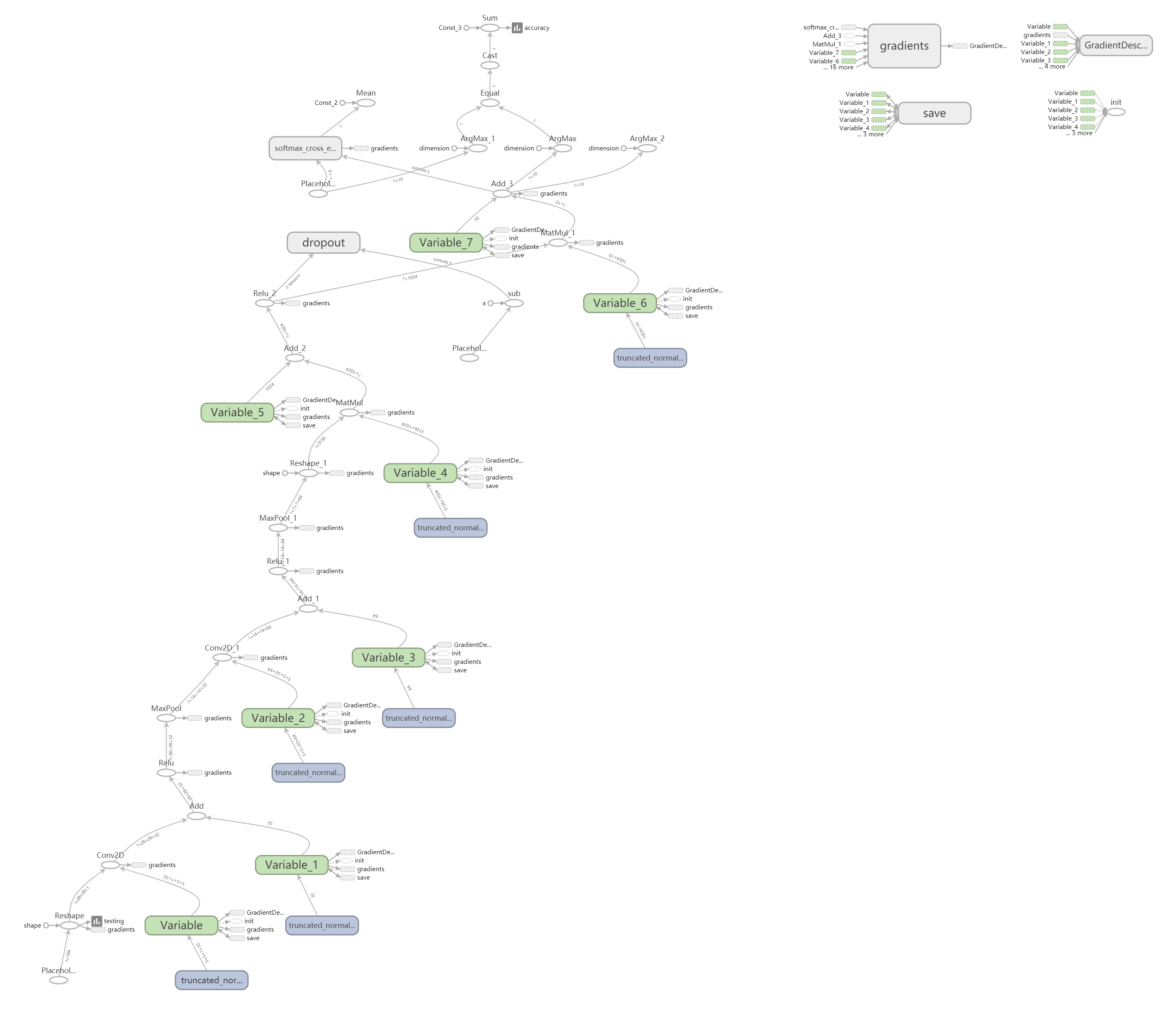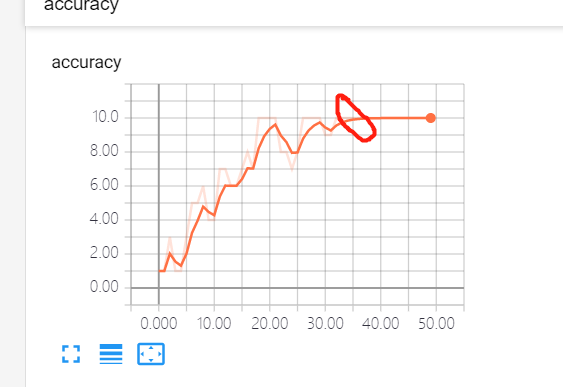tf识别单张图片ocr(0到9的识别)- CNN方式
继上篇文章后,这次使用卷积网络做实验(上篇用的是普通2层网络)

1 2 3 4 5 6 7 8 9 10 11 12 13 14 15 16 17 18 19 20 21 22 23 24 25 26 27 28 29 30 31 32 33 34 35 36 37 38 39 40 41 42 43 44 45 46 47 48 49 50 51 52 53 54 55 56 57 58 59 60 61 62 63 64 65 66 67 68 69 70 71 72 73 74 75 76 77 78 79 80 81 82 83 84 85 86 87 88 89 90 91 92 93 94 95 96 97 98 99 100 101 102 103 104 105 106 107 108 109 110 111 112 113 114 115 116 117 118 119 120 121 122 123 124 125 126 127 128 129 130 131 132 133 134 135 136 | import timeimport tensorflow as tfimport numpy as npimport cv2 as cvdef generate_image(a, rnd_size=100): image = np.zeros([28, 28], dtype=np.uint8) cv.putText(image, str(a), (7, 21), cv.FONT_HERSHEY_PLAIN, 1.3, 255, 2, 8) for i in range(rnd_size): row = np.random.randint(0, 28) col = np.random.randint(0, 28) image[row, col] = 0 data = np.reshape(image, [1, 784]) return image, data / 255def display_images(images): import matplotlib.pyplot as plt size = len(images) for i in range(size): plt.subplot(2, 5, i + 1) plt.imshow(images[i]) plt.show()def load_data(sess, rnd_size=100, should_display_images=False): zero_image, zero = generate_image(0, rnd_size) one_image, one = generate_image(1, rnd_size) two_image, two = generate_image(2, rnd_size) three_image, three = generate_image(3, rnd_size) four_image, four = generate_image(4, rnd_size) five_image, five = generate_image(5, rnd_size) six_image, six = generate_image(6, rnd_size) seven_image, seven = generate_image(7, rnd_size) eight_image, eight = generate_image(8, rnd_size) nine_image, nine = generate_image(9, rnd_size) if should_display_images is True: display_images( [zero_image, one_image, two_image, three_image, four_image, five_image, six_image, seven_image, eight_image, nine_image]) x_features = [zero, one, two, three, four, five, six, seven, eight, nine] x_features = np.array(x_features) x_features = np.reshape(x_features, (-1,784)) y = None y_lables = [0, 1, 2, 3, 4, 5, 6, 7, 8, 9] y = sess.run(tf.one_hot(y_lables, 10)) return x_features, ydef build_network(): x = tf.placeholder(shape=[None, 784], dtype=tf.float32) y = tf.placeholder(shape=[None, 10], dtype=tf.float32) x_image = tf.reshape(x, [-1, 28, 28, 1]) # convolution layer 1 conv1_w = tf.Variable(tf.truncated_normal(shape=[5, 5, 1, 32], stddev=0.1, dtype=tf.float32)) conv1_bias = tf.Variable(tf.truncated_normal(shape=[32], stddev=0.1)) conv1_out = tf.nn.conv2d(input=x_image, filter=conv1_w, strides=[1, 1, 1, 1], padding='SAME') conv1_relu = tf.nn.relu(tf.add(conv1_out, conv1_bias)) # max pooling 1 maxpooling_1 = tf.nn.max_pool(conv1_relu, ksize=[1, 2, 2, 1], strides=[1, 2, 2, 1], padding='SAME') # convolution layer 2 conv2_w = tf.Variable(tf.truncated_normal(shape=[5, 5, 32, 64], stddev=0.1, dtype=tf.float32)) conv2_bias = tf.Variable(tf.truncated_normal(shape=[64], stddev=0.1)) conv2_out = tf.nn.conv2d(input=maxpooling_1, filter=conv2_w, strides=[1, 1, 1, 1], padding='SAME') conv2_relu = tf.nn.relu(tf.add(conv2_out, conv2_bias)) # max pooling 2 maxpooling_2 = tf.nn.max_pool(conv2_relu, ksize=[1, 2, 2, 1], strides=[1, 2, 2, 1], padding='SAME') # fc-1 w_fc1 = tf.Variable(tf.truncated_normal(shape=[7*7*64, 1024], stddev=0.1, dtype=tf.float32)) b_fc1 = tf.Variable(tf.constant(0.1, shape=[1024])) h_pool2 = tf.reshape(maxpooling_2, [-1, 7*7*64]) output_fc1 = tf.nn.relu(tf.add(tf.matmul(h_pool2, w_fc1), b_fc1)) # dropout keep_prob = tf.placeholder(dtype=tf.float32) h2 = tf.nn.dropout(output_fc1, keep_prob=keep_prob) # fc-2 w_fc2 = tf.Variable(tf.truncated_normal(shape=[1024, 10], stddev=0.1, dtype=tf.float32)) b_fc2 = tf.Variable(tf.constant(0.1, shape=[10])) y_conv = tf.add(tf.matmul(output_fc1, w_fc2), b_fc2) cross_loss = tf.nn.softmax_cross_entropy_with_logits(logits=y_conv, labels=y) loss = tf.reduce_mean(cross_loss) step = tf.train.GradientDescentOptimizer(0.05).minimize(loss) # accuracy acc_mat = tf.equal(tf.argmax(y_conv, 1), tf.argmax(y, 1)) acc = tf.reduce_sum(tf.cast(acc_mat, tf.float32)) prediction = tf.argmax(y_conv, 1) tf.summary.scalar("accuracy", acc) tf.summary.image('testing', x_image, max_outputs = 10) return x, y, step, acc, acc_mat, prediction, keep_probdef train(): x, y, step, acc, acc_mat, prediction, keep_prob = build_network() with tf.Session() as sess: saver = tf.train.Saver() sess.run(tf.global_variables_initializer()) summary_merged = tf.summary.merge_all() #必须放在初始化的后面,否则报错 writer = tf.summary.FileWriter('logs'+str(time.time()), sess.graph) for i in range(50): x_features, y_lables = load_data(sess) _, summary_ = sess.run([step, summary_merged], feed_dict={x: x_features, y: y_lables, keep_prob: 0.5}) writer.add_summary(summary_, i) if (i + 1) % 5 == 0: curr_acc = sess.run(acc, feed_dict={x: x_features, y: y_lables, keep_prob: 1.0}) print("current test Accuracy : %f" % (curr_acc)) saver.save(sess, "./checkpoint/tf_mnist.model", global_step=50) writer.close() print('*************************') x_features, y_labels = load_data(sess, 300, should_display_images=True) pred_ys = sess.run(prediction, feed_dict={x: x_features, keep_prob: 1.0}) print('图片识别结果:', pred_ys)if __name__ == '__main__': train() |

current test Accuracy : 4.000000 current test Accuracy : 7.000000 current test Accuracy : 7.000000 current test Accuracy : 10.000000 current test Accuracy : 8.000000 current test Accuracy : 10.000000 current test Accuracy : 10.000000 current test Accuracy : 10.000000 current test Accuracy : 10.000000 current test Accuracy : 10.000000 ************************* 图片识别结果: [0 1 2 3 4 5 6 7 8 9]


我们可以看到,在用卷积网络做训练时,大概35此迭代就实现了正确率达到了10张图片全部识别正确,但是普通2层全连接网络需要花费大概400次迭代才能达到100%正确率
自省推动进步,视野决定未来。
心怀远大理想。
为了家庭幸福而努力。
商业合作请看此处:https://www.magicube.ai
心怀远大理想。
为了家庭幸福而努力。
商业合作请看此处:https://www.magicube.ai





【推荐】国内首个AI IDE,深度理解中文开发场景,立即下载体验Trae
【推荐】编程新体验,更懂你的AI,立即体验豆包MarsCode编程助手
【推荐】抖音旗下AI助手豆包,你的智能百科全书,全免费不限次数
【推荐】轻量又高性能的 SSH 工具 IShell:AI 加持,快人一步
· 如何编写易于单元测试的代码
· 10年+ .NET Coder 心语,封装的思维:从隐藏、稳定开始理解其本质意义
· .NET Core 中如何实现缓存的预热?
· 从 HTTP 原因短语缺失研究 HTTP/2 和 HTTP/3 的设计差异
· AI与.NET技术实操系列:向量存储与相似性搜索在 .NET 中的实现
· 地球OL攻略 —— 某应届生求职总结
· 周边上新:园子的第一款马克杯温暖上架
· Open-Sora 2.0 重磅开源!
· 提示词工程——AI应用必不可少的技术
· .NET周刊【3月第1期 2025-03-02】
2014-02-12 消息队列工具类(MSMQ)